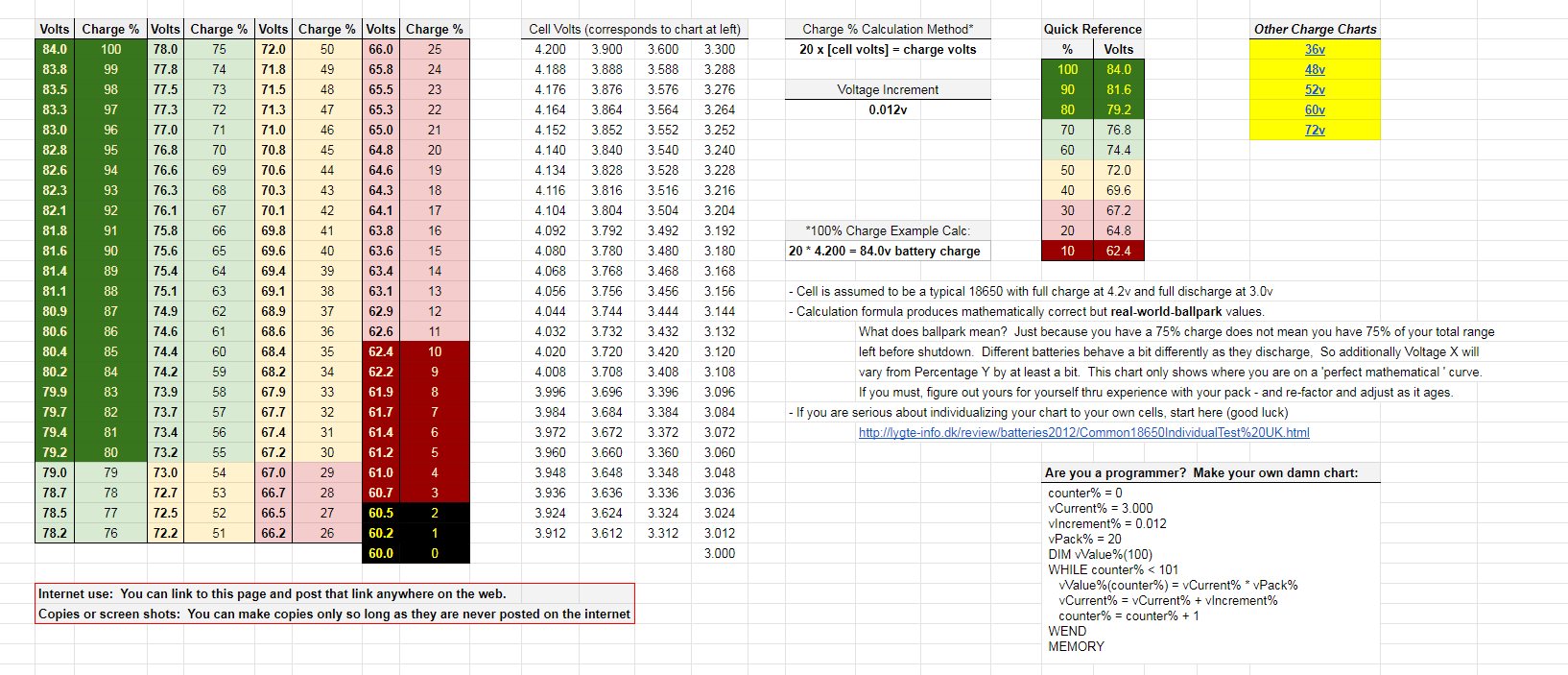A 48v battery is fully charged at 54.6v. The low voltage cutoff is around 39v. It is best not to discharge more than 80% of the capacity for good cycle life. 80% DOD is around 43v depending on cell chemistry. Li-ion has a flat discharge curve. The voltage will drop from 54.6v down to 50v fairly quickly then level off. Below 42v the voltage drops off quickly and there is not much remaining capacity left. The cells heat up at this point as well.


You are using an out of date browser. It may not display this or other websites correctly.
You should upgrade or use an alternative browser.
You should upgrade or use an alternative browser.
48 Volt (13S) Battery Voltage Chart - Li-Ion Batteries
- Thread starter Anton
- Start date
40buickcoupe
Member
- Local time
- 9:53 AM
- Joined
- Dec 23, 2021
- Messages
- 36
very good information intresting bpth my batteries will only fully charge to 54.4 volts
CloneWerks
Well-known member
54-ish Volts is the common "cut off point". There is some variation depending on the age and cycles of individual cells inside the pack.very good information intresting bpth my batteries will only fully charge to 54.4 volts
JerryB
Well-known member
Here ya go.....Good information. I have two eBikes. One has 52V batteries and the other has 48V batteries. Does anyone have a similar chart they can post for 52V batteries?

Li-Ion Ebike Battery Charge Charts
Whats an 80% charge on a 48v battery? These charts give answers to questions like this on common ebike battery voltages: 36v, 48v, 52v, 60v and 72v.
 talesontwowheels.com
talesontwowheels.com
40buickcoupe
Member
- Local time
- 9:53 AM
- Joined
- Dec 23, 2021
- Messages
- 36
Anton do you have the chart in a PDF or a excell format you could send me?
I've just created a theoretical chart here which you should be able to copy into excel: https://ebikesforum.com/resources/48-volt-13s-battery-voltage-chart-li-ion-ebike-batteries.37/Anton do you have the chart in a PDF or a excell format you could send me?
40buickcoupe
Member
- Local time
- 9:53 AM
- Joined
- Dec 23, 2021
- Messages
- 36
thank you worked great
Lotta Life Lefty
New member
I have recently purchased two 48v ebikes. When the charge is complete (green light on) I have checked the voltage on the display and on both bikes it reads 53.4v.A 48v battery is fully charged at 54.6v. The low voltage cutoff is around 39v. It is best not to discharge more than 80% of the capacity for good cycle life. 80% DOD is around 43v depending on cell chemistry. Li-ion has a flat discharge curve. The voltage will drop from 54.6v down to 50v fairly quickly then level off. Below 42v the voltage drops off quickly and there is not much remaining capacity left. The cells heat up at this point as well.
View attachment 419
View attachment 418
The chargers that came with the bikes say they are 54.6v and 2amp...
I am a bit confused as I have read and seen numerous charts that 54.6v is 100% charge on 48v ebike batterys, yet I see the chart above that indicates 53v is 100% charge which corresponds with my ebike readings.
Any clarification would be helpful...
Thanks!
Smaug
Well-known member
48 V is the nominal voltage. The actual battery voltage will vary depending on state of charge and what its load is at that moment.I have recently purchased two 48v ebikes. When the charge is complete (green light on) I have checked the voltage on the display and on both bikes it reads 53.4v.
The chargers that came with the bikes say they are 54.6v and 2amp...
I am a bit confused as I have read and seen numerous charts that 54.6v is 100% charge on 48v ebike batterys, yet I see the chart above that indicates 53v is 100% charge which corresponds with my ebike readings.
Any clarification would be helpful...
Thanks!
As you noticed a 48 V battery at full charge with no load is more like 53 V.
If your display will show instantaneous voltage, you will see it sag down when you give it some throttle, then it comes back up when the load is removed.
Example: I was out riding my 52 V-rated eMoped last night. It was at around 54 V when I left, so not quite fully charged. When I hit the throttle, I noticed it sag down to around 49 V. I didn't notice the no-load voltage when I was done with the ride.
Anton provided some voltage charts that correlate state-of-charge with no-load voltage measurements; search them up if you're curious.
I have recently purchased two 48v ebikes. When the charge is complete (green light on) I have checked the voltage on the display and on both bikes it reads 53.4v.
The chargers that came with the bikes say they are 54.6v and 2amp...
I am a bit confused as I have read and seen numerous charts that 54.6v is 100% charge on 48v ebike batterys, yet I see the chart above that indicates 53v is 100% charge which corresponds with my ebike readings.
Any clarification would be helpful...
Thanks!
Have a look at my other 48V battery chart here which shows 54.6V as 100%: https://ebikesforum.com/resources/48-volt-13s-battery-voltage-chart-li-ion-batteries.37/
Calculation: 13 Cells x 4.2 Volts/Cell = 54.6 Volts Fully Charged
Assumptions: Your pack uses typical 18650 cells which charge to 4.2V and discharge to 3.0V.
Similar threads
- Replies
- 12
- Views
- 3K
- Replies
- 6
- Views
- 3K